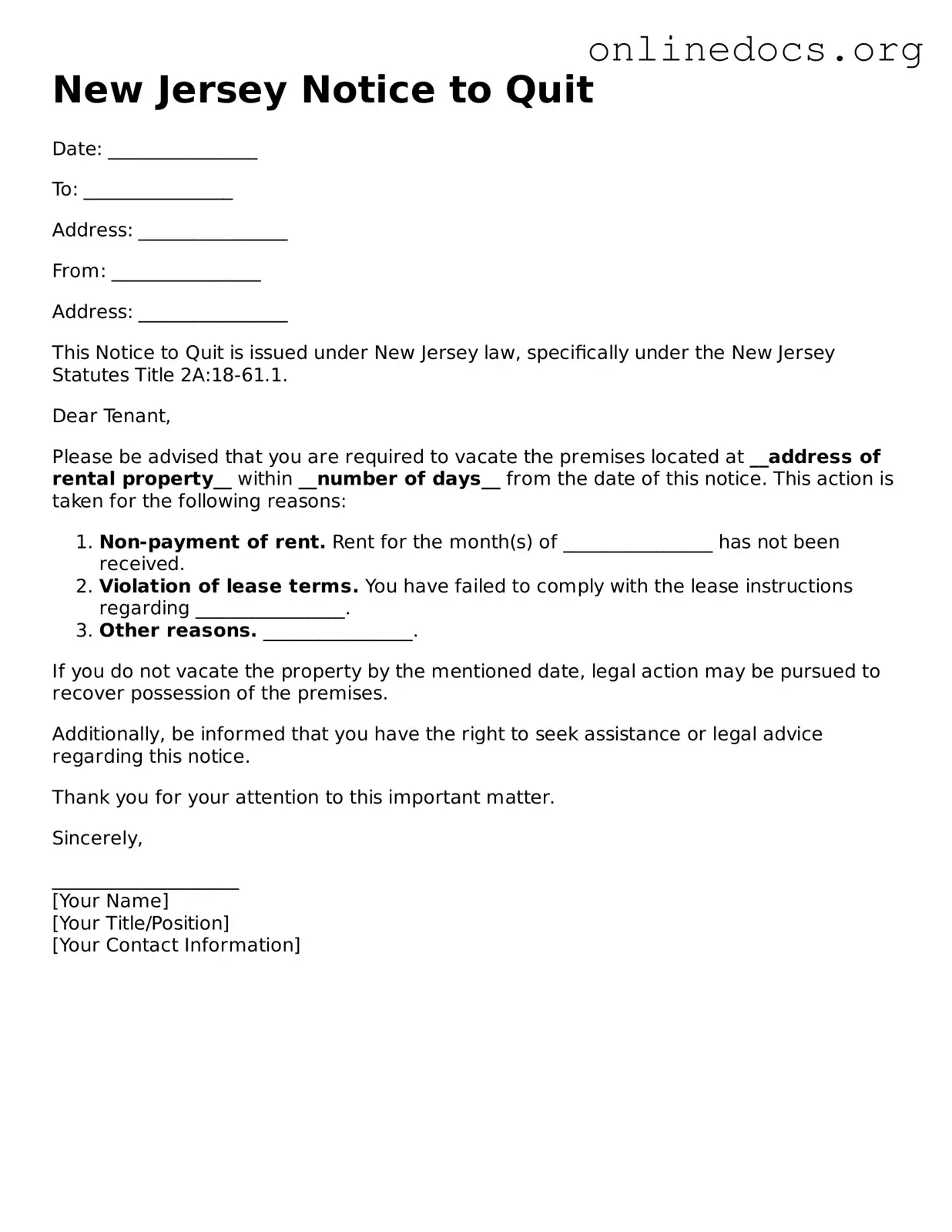The New Jersey Notice to Quit form is similar to the Eviction Notice used in many states. Both documents serve the purpose of informing a tenant that they must vacate the premises. An Eviction Notice typically outlines the reasons for the eviction, such as non-payment of rent or lease violations. It also specifies a deadline for the tenant to leave, similar to the timeframes often found in a Notice to Quit. This document is a crucial step in the eviction process, as it formally notifies the tenant of the landlord's intention to pursue eviction if the issue is not resolved.
The Demand for Possession is another document that shares similarities with the Notice to Quit. This document is often used by landlords to demand that a tenant vacate the property due to non-compliance with lease terms. Like the Notice to Quit, the Demand for Possession sets a clear deadline for the tenant to vacate. It may also include details about the specific lease violations that prompted the demand, ensuring the tenant understands the reason for the request to leave.
The 3-Day Notice to Pay Rent or Quit is a specific type of eviction notice that focuses solely on non-payment of rent. This document is similar to the Notice to Quit in that it requires the tenant to either pay the overdue rent or vacate the property within a specified timeframe. The urgency of the 3-Day Notice emphasizes the landlord's need for timely payment, making it a direct precursor to further legal action if the tenant fails to comply.
The 30-Day Notice to Terminate Tenancy is a document used to end a month-to-month rental agreement. It is similar to the Notice to Quit because it formally notifies the tenant of the landlord's intention to terminate the lease. While the Notice to Quit may be used for specific violations, the 30-Day Notice provides a broader reason for termination, allowing landlords to end a tenancy without needing to cite specific infractions. This document also outlines the required notice period, ensuring both parties are aware of the timeline for vacating the premises.
The Lease Termination Letter is another document that resembles the Notice to Quit. This letter is often used by landlords to inform tenants that their lease will not be renewed at the end of the term. Similar to the Notice to Quit, it provides a clear indication of the landlord's intentions and specifies the date by which the tenant must vacate. This document helps establish clear communication between the landlord and tenant regarding the end of the tenancy.
The Notice of Lease Violation serves a different purpose but shares common ground with the Notice to Quit. This document is issued when a tenant breaches the terms of their lease agreement. While the Notice to Quit demands that the tenant vacate, the Notice of Lease Violation typically gives the tenant an opportunity to rectify the situation before eviction proceedings begin. Both documents aim to address issues within the landlord-tenant relationship, but the Notice of Lease Violation allows for a chance to correct the behavior before further action is taken.
In addition to the previously mentioned documents, it's essential to note that the New York Trailer Bill of Sale form is equally crucial for transactions involving trailers in New York. This form secures the interests of both buyer and seller while complying with state laws, making it a critical component of trailer ownership transfers. For more detailed information on how to properly complete this form, you can visit legalformspdf.com.
The Cure or Quit Notice is another document that parallels the Notice to Quit. This notice is used when a tenant has violated the lease terms, but the landlord allows the tenant a chance to remedy the situation. The Cure or Quit Notice specifies the violation and gives the tenant a certain period to correct it. If the tenant fails to comply, the landlord may then proceed with eviction. This document emphasizes the importance of communication and resolution in the landlord-tenant relationship, similar to the intent behind the Notice to Quit.
